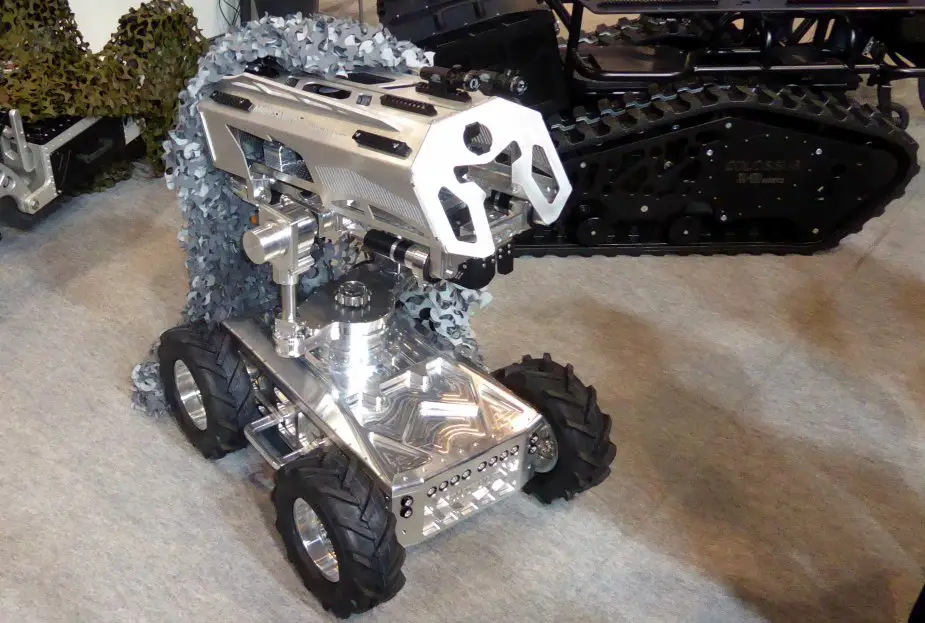Breaking news
Eurosatory 2018: French company SD4E unveils Snibot as hyperprecision robot for sniping.
In urban combat, the military is still numerically overwhelmed by the civilian population, in which plainclothes fighters are very often hidden. The military therefore needs to be assisted by robots that will relieve them of a series of tasks devouring energy and time.

SD4E's "Snibot", a new generation of hyper-precision robot dedidacted to sniping (Picture source: Army Recognition)
One thinks in particular of the shooting but on this point, it is essential to develop a new generation of robots whose abilities exceed what exists nowadays. It is a question of realizing devices that guarantee 100% success of single shots or simultaneous shots up to 200 meters, with a precision that allows to program the robot (s) so that the projectile (s) reach an arm or a leg to immobilize the target (s) without killing them. General (ret.) Michel Yakovleff, head of export development at SD4E, invokes the interest in successfully preventing terrorists from blowing themselves up by injuring them: properly cured, cleverly "worked", some "suicide bombers" would probably change of attitude and deliver very valuable information to trace the path of their organization. A delight for intelligence men!
Another application planned for hyper-precise robots: the defense of sensitive sites such as nuclear power plants. The imperative need to reach very precisely intruders evolving in a predefined perimeter does not escape anyone. In peacetime, it is primarily a matter of hurting rather than killing one or more individuals who have entered one of the most sensitive buildings in a complex where their presence defines them as malicious and their immediate arrest considered as impossible. And precisely in this hypothesis where a robot is called to intervene, there will always be a human control by a representative of the judicial authority and all the legal procedure will be respected, with the advantage that the intervention of the robots will be recorded, allowing to perfectly document the file. The system will not fall under suspicion or outright the accusation of letting a robot decide instead of the human being. On the other hand, it is possible that the presence of such a device dissuades many potential malevolent who would be faced with the virtual certainty of losing an arm or a leg in the adventure... This new form of defense would significantly raise the threshold of the impunity enjoyed so far by a number of malicious militants.
To defend a military installation, instead of using a certain number of sentinels whose vigilance may be in default or the time and choice of the reaction prove fatal, one could install rails on the perimeter and circulate robots programmed to react instantly according to the parameters loaded in relation to the places, the types of threats envisaged, the restrictions applicable, etc. Again, depending on the parameters of the situation encountered, the robot would execute the human decision to fire to injure or kill with a precision and speed almost unparalleled. The robots would be of an eclipse type to prevent their preventive destruction.
Such a device would massively save the workforce today assigned to the protection of infrastructures in external operation: it is necessary to deploy five people to have one permanently on the parapet. A site requiring a dozen defenders permanently (a fairly common case) requires the deployment of fifty soldiers. In the present case, a Snibot-based defense system would allow a significant number of soldiers to be redirected to missions outside the perimeter, while ensuring a defense with guaranteed effect, not subject to fatigue, stress, etc.
Another ideal example of using a hyper-accurate robot is taking hostage (s), especially by several individuals. Instead of forcing a team of snipers at this grueling countdown simultaneously to shoot only when all the hostage takers are in sight at the same time to prevent one of them from executing the hostages after seeing his accomplices shot down, Snibots, under the authority of the judiciary represented on site, would execute this sequence of shooting. The usual interruptions and resumptions of the countdown would no longer weigh on shooters. Many years ago, during a hostage crisis in Djibouti, the French snipers literally cooked under the sun for several hours before the shooting window allowed all hostage takers to be shot down simultaneously. Psychologically and physically, the snipers would be relieved of a certain number of interventions, provided, once again, that the level of hyper-precision required, together with a reliability covered by the judicial authority, to replace the human being.
To develop such a hyper-precision robot, Philippe Levilly, project manager in the SD4E company he created for this purpose, surrounded himself with strategic collaborators: Alain Juillet (recognized authority in security and intelligence ), to preside over it; Michel Yakovleff (ret. general, Export Development Officer); Frédéric Gallois (operational advisor), Jean-Pierre Devaux (director of strategy); Jean-Jacques Topalian, strategic partner and specialist in Mechatronics (via Shark Robotics); last but not least, Etienne Besnard from MGPI (General Precision Engineering). SD4E adopted a particular angle of view: it did not start from a weapon to adapt to a robot, nor a robot that should be adapted to a role of sniper. No, he started from the high-precision shooting to realize and, therefore, develop the robot necessary to accomplish this task.
The army is convinced of the imperative need to develop robots for a series of tasks to be performed under often complex operational conditions. This requires a large budget. But, for reference, as the U.S. Army Chief of Staff said: "The US Army has only 4% of its members who use a personal weapon to fight but these 4% represent 90% of the losses while they receive only 1% of the annual budget. It is time for this to change and these troops in direct contact with the enemy to receive 10% of the budget! ". What is true for the US Army is also relevant for others, of course.


























